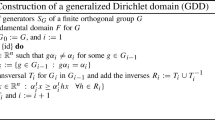Abstract
The Social Golfer Problem has been extensively used in recent years by the constraint community as an example of highly symmetric problem. It is an excellent problem for benchmarking symmetry breaking mechanisms such as SBDS or SBDD and for demonstrating the importance of the choice of the right model for one problem. We address in this paper a specific instance of the Golfer Problem well known as the Kirkman’s Schoolgirl Problem and list a collection of techniques and tricks to find efficiently all its unique solutions. In particular, we propose SBDD+, an generic improvement over SBDD which allows a deep pruning when a symmetry is detected during the search. Our implementation of the presented techniques allows us to improve previous published results by an order of magnitude for CPU time as well as number of backtracks, and to compute the seven unique solutions of the Kirkman’s problem in a few seconds.
Access this chapter
Tax calculation will be finalised at checkout
Purchases are for personal use only
Preview
Unable to display preview. Download preview PDF.
Similar content being viewed by others
References
Nicolas Barnier and Pascal Brisset. Facile: a functional constraint library. In Proceeding of CICLOPS2001, Paphos, 2001.
M. B. Cohen, C. J. Colbourn, L. A. Ives, and A. C. H. Ling. Kirkman triple systems of order 21 with nontrivial automorphism group. Mathematics of Computation, 2001.
CP’01: 7th International Conference on Principle and Practice of Constraint Programming, Paphos, Cyprus, 2001.
CPAIOR’ 02: Fourth International Workshop on Integration of AI and OR Techniques in Constraint Programming for Combinatorial Optimisation Problems, Le Croisic, France, 2002.
Torsten Fahle, Stefan Schamberger, and Meinolf Sellmann. Symmetry breaking. In CP’01 [3], pages 93–107.
Filippo Focacci and Michaela Milano. Global cut framework for removing symmetries. In CP’01 [3], pages 77–92.
I. Gent, T. Walsh, and B. Selman. CSPlib: a problem library for constraints, http://www-users.cs.york.ac.uk/~tw/csplib.
I. P. Gent and Barbara Smith. Symmetry breaking during search in contraint programming. In W. Horn, editor, EACI’2000, pages 599–603, 2000.
Carmen Gervet. Interval propagation to reason about sets: Definition and implementation of a practical language. Constraints, 1(3):191–244, 1997. http://www.icparc.ic.ac.uk/~cg6.
J. Hopcroft and R. Karp. An n 5/2 algorithm for maximum matching in bipartite graphs. SI AM Journal of Computing, 2(4):225–231, 1973.
T. P. Kirkman. Note on an unanswered prize question. Cambridge and Dublin Mathematics Journal, 5:255–262, 1850.
JR Marshall Hall. Combinatorial Theory. Wiley Classics Library, second edition edition, 1983.
Brendan D. McKay. Practical graph isomorphism. Congressus Numerantium, 30:45–87, 1981.
Steven Prestwich. Randomised backtracking for linear pseudo-boolean constraint problems. In CPAIOR’02 [4], pages 7–19.
Jean-Charles Régin. Generalized arc consistency for global cardinality constraint. In Proceedings of the Thirteenth National Conference on Artificial Intelligence, 1996.
Andre Sadler and Carmen Gervet. Global reasoning on sets. In Formul’01, Workshop Modelling and Problem Formulation, 2001.
Meinolf Sellmann and Warwick Harvey. Heuristic constraint propagation. In CPAIOR’02 [4], pages 191–204.
Barbara Smith. Reducing symmetry in a combinatorial design problem. In CPAIOR’01, pages 351–359, April 2001. http://www.icparc.ic.ac.uk/cpAIOR01.
Author information
Authors and Affiliations
Editor information
Editors and Affiliations
Rights and permissions
Copyright information
© 2002 Springer-Verlag Berlin Heidelberg
About this paper
Cite this paper
Barnier, N., Brisset, P. (2002). Solving the Kirkman’s Schoolgirl Problem in a Few Seconds. In: Van Hentenryck, P. (eds) Principles and Practice of Constraint Programming - CP 2002. CP 2002. Lecture Notes in Computer Science, vol 2470. Springer, Berlin, Heidelberg. https://doi.org/10.1007/3-540-46135-3_32
Download citation
DOI: https://doi.org/10.1007/3-540-46135-3_32
Published:
Publisher Name: Springer, Berlin, Heidelberg
Print ISBN: 978-3-540-44120-5
Online ISBN: 978-3-540-46135-7
eBook Packages: Springer Book Archive




